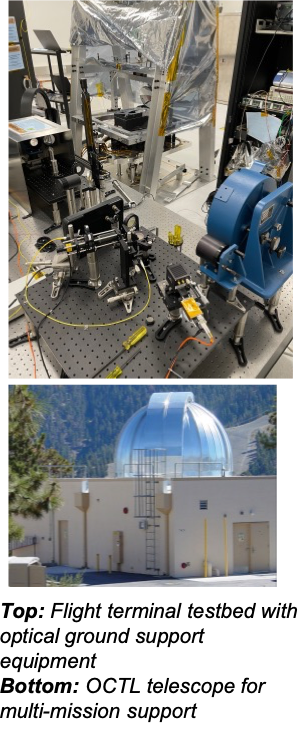
The Optical Communications Laboratory consists of several facilities:
- Flight Terminal Testbed
- Laser Testing Laboratory
- Optical Detector and Receiver Testing Laboratory
- Optical Communication Telescope Laboratory (OCTL) at the Table Mountain Observatory
This laboratory supports ongoing projects:
- Deep Space Optical Communications (DSOC): Flight terminal on Psyche Mission spacecraft with ground stations at Table Mountain, CA and Palomar Observatory, CA demonstrates high-rate communications from space-to-ground over Mars distances. Operating since the launch of Psyche spacecraft in October 2013 with a planned mission duration until September 2025.
- Laser Communication Relay Demonstration (LCRD) Project: Optical Ground Station 1 (OGS 1) at OCTL operates bi-directional links to a geostationary platform using coherent modulation requiring atmospheric turbulence induced aberration correction. This technology demonstration is in its third year of operations.
- Optical-to-Orion (O2O) project ground terminal at OCTL, partners with NASA Goddard, MIT-Lincoln Laboratory and Johnson Space Center, in advanced integration and test phase for ARTEMIS II crewed launch from cis-lunar distances.
- Atmospheric and weather monitoring: activities at Table Mountain and Goldstone includes years of atmospheric attenuation, sky brightness, atmospheric “seeing” and cloud cover statistics using an instrument suite deployed in the field supported by calibration activities at JPL.
Personnel / Contacts:
Ongoing Research Projects:
- Deep Space Optical Communications (DSOC)
- Laser Communications Relay Demonstration (LCRD)
- Optical-to-Orion Ground Terminal